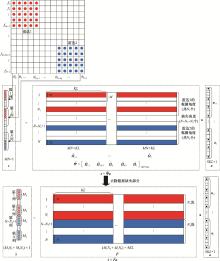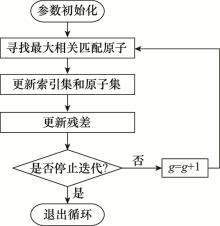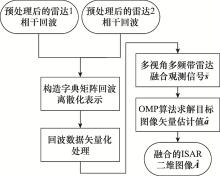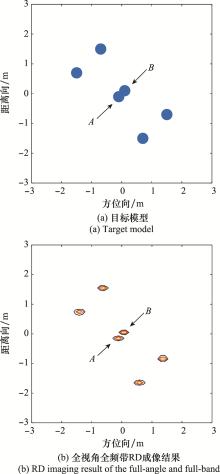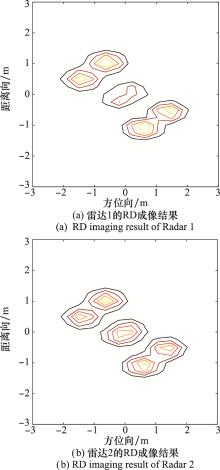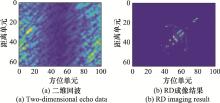Systems Engineering and Electronics ›› 2023, Vol. 45 ›› Issue (3): 726-735.doi: 10.12305/j.issn.1001-506X.2023.03.13
• Sensors and Signal Processing • Previous Articles Next Articles
Multi-angle and multi-band ISAR fusion imaging based on GTD model
Xiaoxiu ZHU1,2, Limin LIU1,*, Wenhua HU1, Baofeng GUO1, Lin SHI1, Hanshen ZHU1
- 1. Department of Electronic and Optical Engineering, Army Engineering University Shijiazhuang Campus, Shijiazhuang 050003, China
2. Unit 32398 of the PLA, Beijing 100192, China
-
Received:2021-03-25Online:2023-02-25Published:2023-03-09 -
Contact:Limin LIU
CLC Number:
Cite this article
Xiaoxiu ZHU, Limin LIU, Wenhua HU, Baofeng GUO, Lin SHI, Hanshen ZHU. Multi-angle and multi-band ISAR fusion imaging based on GTD model[J]. Systems Engineering and Electronics, 2023, 45(3): 726-735.
share this article
| 1 |
ZENG C Z , ZHU W G , JIA X , et al. Sparse aperture ISAR imaging method based on joint constraints of sparsity and low rank[J]. IEEE Trans.on Geoscience and Remote Sensing, 2021, 59 (1): 168- 181.
doi: 10.1109/TGRS.2020.2994179 |
| 2 |
QIU W , ZHOU J X , FU Q . Jointly using low-rank and sparsity priors for sparse inverse synthetic aperture radar imaging[J]. IEEE Trans.on Image Processing, 2020, 29, 100- 115.
doi: 10.1109/TIP.2019.2927458 |
| 3 |
ZHANG S H , LIU Y X , LI X . Fast sparse aperture ISAR autofocusing and imaging via ADMM based sparse Bayesian learning[J]. IEEE Trans.on Image Processing, 2020, 29, 3213- 3226.
doi: 10.1109/TIP.2019.2957939 |
| 4 |
XIANG L , LI S D , YANG J , et al. A fast decoupled ISAR high-resolution imaging method using structural sparse information under low SNR[J]. Journal of Systems Engineering and Electronics, 2019, 30 (3): 492- 503.
doi: 10.21629/JSEE.2019.03.07 |
| 5 |
ZHANG C , ZHANG S H , LIU Y X , et al. Joint structured sparsity and least entropy constrained sparse aperture radar imaging and autofocusing[J]. IEEE Trans.on Geoscience and Remote Sensing, 2020, 58 (9): 6580- 6593.
doi: 10.1109/TGRS.2020.2978096 |
| 6 |
GIUSTI E , CATALDOA D , BACCI A , et al. ISAR image resolution enhancement: compressive sensing versus state-of-the-art super-resolution techniques[J]. IEEE Trans.on Aerospace and Electronic Systems, 2018, 54 (4): 1983- 1997.
doi: 10.1109/TAES.2018.2807283 |
| 7 |
WEI S P , ZHANG L , MA H , et al. Sparse frequency waveform optimization for high-resolution ISAR imaging[J]. IEEE Trans.on Geoscience and Remote Sensing, 2020, 58 (1): 546- 566.
doi: 10.1109/TGRS.2019.2937965 |
| 8 |
RONG J J , WANG Y , HAN T . Iterative optimization-based ISAR imaging with sparse aperture and its application in interferometric ISAR imaging[J]. IEEE Sensors Journal, 2019, 19 (19): 8681- 8693.
doi: 10.1109/JSEN.2019.2923447 |
| 9 |
ZHOU F , BAI X R . High-resolution sparse subband imaging based on Bayesian learning with hierarchical priors[J]. IEEE Trans.on Geoscience and Remote Sensing, 2018, 56 (8): 4568- 4580.
doi: 10.1109/TGRS.2018.2827072 |
| 10 |
ZHANG Y , WANG T J , ZHAO H P , et al. Multiple radar subbands fusion algorithm based on support vector regression in complex noise environment[J]. IEEE Trans.on Antennas and Propagation, 2018, 66 (1): 381- 392.
doi: 10.1109/TAP.2017.2769135 |
| 11 | VANN L D, CUOMO K M. Multisensor fusion processing for enhanced radar imaging[R]. Lexington: Lincoln Laboratory, 2000. |
| 12 |
YI L , DING D Z , CHEN R S , et al. Multi-radar fusion technique for high-resolution ISAR imaging in sea-cluttered environment[J]. The Journal of Engineering, 2019, 2019 (20): 6898- 6901.
doi: 10.1049/joe.2019.0367 |
| 13 |
LIU C , TAO S , DING D Z , et al. Multi-radar target parameter estimation and fusion based on attribute scattering centre model[J]. The Journal of Engineering, 2019, 2019 (20): 6894- 6897.
doi: 10.1049/joe.2019.0340 |
| 14 |
ZOU Y Q , GAO X Z , LI X , et al. A matrix pencil algorithm based multiband iterative fusion imaging method[J]. Scientific Reports, 2016, 6, 19440.
doi: 10.1038/srep19440 |
| 15 | JI B R , ZHAO B , WANG Y , et al. Novel sparse apertures ISAR imaging algorithm via the TLS-ESPRIT technique[J]. IET Radar, Sonar & Navigation, 2020, 14 (6): 852- 859. |
| 16 | 熊娣, 王俊岭, 赵莉芝, 等. 基于酉ESPRIT的多频带融合ISAR成像[J]. 电子与信息学报, 2019, 41 (2): 286- 292. |
| XIONG D , WANG J L , ZHAO L Z , et al. Unitary ESPRIT based multiband fusion ISAR imaging[J]. Journal of Electronics & Information Technology, 2019, 41 (2): 286- 292. | |
| 17 |
LIU Q C , WANG Y , ZHANG Q X . ISAR cross-range scaling based on the MUSIC technique[J]. Journal of Systems Engineering and Electronics, 2020, 31 (5): 928- 938.
doi: 10.23919/JSEE.2020.000070 |
| 18 |
HU P J , XU S Y , WU W Z , et al. Sparse subband ISAR imaging based on autoregressive model and smoothed l0 algorithm[J]. IEEE Sensors Journal, 2018, 18 (22): 9315- 9323.
doi: 10.1109/JSEN.2018.2869832 |
| 19 |
BAI X R , ZHOU F , WANG Q , et al. Sparse subband imaging of space targets in high-speed motion[J]. IEEE Trans.on Geoscience and Remote Sensing, 2013, 51 (7): 4144- 4154.
doi: 10.1109/TGRS.2012.2227756 |
| 20 | CHEN D Z, LUO X, TAO S F, et al. Multi radar imaging based on variational Bayesian block sparse method[C]//Proc. of the IEEE International Conference on Computational Electromagnetics, 2018. |
| 21 |
YE F , LIANG D , ZHU J . ISAR enhancement technology based on compressed sensing[J]. Electronics Letters, 2011, 47 (10): 620- 621.
doi: 10.1049/el.2011.0117 |
| 22 | 叶钒, 何峰, 张永胜, 等. 基于GTD模型的多雷达信号二维融合[J]. 电子与信息学报, 2011, 33 (1): 55- 59. |
| YE F , HE F , ZHANG Y S , et al. Two-dimensional fusion of multi-radar signals based on GTD model[J]. Journal of Electronics & Information Technology, 2011, 33 (1): 55- 59. | |
| 23 |
GHASEMI M , SHEIKHI A . Joint Scattering center enumeration and parameter estimation in GTD model[J]. IEEE Trans.on Antennas and Propagation, 2020, 68 (6): 4786- 4798.
doi: 10.1109/TAP.2020.2975197 |
| 24 | TIAN B , CHEN Z P , XU S Y . Sparse subband fusion imaging based on parameter estimation of geometrical theory of diffraction model[J]. IET Radar, Sonar & Navigation, 2014, 8 (4): 318- 326. |
| 25 | XU J, SONG D W, DING D Z, et al. High resolution 2D-imaging based on data fusion technique[C]//Proc. of the IEEE International Conference on Computational Electro-magnetics, 2018. |
| 26 | 何邦昱. 基于快速稀疏贝叶斯学习算法的雷达数据融合技术研究[D]. 南京: 南京理工大学, 2014: 46-48. |
| HE B Y. Research on radar data fusion technology based on fast sparse Bayesian learning algorithm[D]. Nanjing: Nanjing University of Science and Technology, 2014: 46-48. | |
| 27 | 陈栋志. 基于块稀疏变分贝叶斯的雷达成像方法研究[D]. 南京: 南京理工大学, 2018: 36-37. |
| CHEN D Z. Research on radar imaging method based on block sparse variational Bayes[D]. Nanjing: Nanjing University of Science and Technology, 2018: 36-37. | |
| 28 |
TROPP J A , GILBERT A C . Signal recovery from random measurements via orthogonal matching pursuit[J]. IEEE Trans.on Information Theory, 2007, 53 (12): 4655- 4666.
doi: 10.1109/TIT.2007.909108 |
| 29 |
CHENG P , WANG X X , ZHAO J Q , et al. A fast and accurate compressed sensing reconstruction algorithm for ISAR ima-ging[J]. IEEE Access, 2019, 7, 157019- 157026.
doi: 10.1109/ACCESS.2019.2949756 |
| 30 |
ZHU X X , GUO B F , HU W H , et al. Scene segmentation of multi-band ISAR fusion imaging based on MB-PCSBL[J]. IEEE Sensors Journal, 2021, 21 (3): 3520- 3532.
doi: 10.1109/JSEN.2020.3026109 |
| [1] | JU Yan-wei, ZHANG Yan. Research on ISAR image quality evaluation [J]. Systems Engineering and Electronics, 2015, 37(2): 297-303. |
| [2] | LI Shao-dong, PEI Wen-jiong, YANG Jun, HU Guo-qi. OMP reconstruction algorithm via Bayesian model and its application [J]. Systems Engineering and Electronics, 2015, 37(2): 246-252. |
| [3] | ZHANG Kun-fan, PEI Xi-long, DANG Tong-xin, ZHANG Ya-ge. Estimating method for the rotation angle of ISAR image based on spectral envelope correlation [J]. Systems Engineering and Electronics, 2014, 36(8): 1511-1516. |
| [4] | YANG Guo-jun, HE Zhi-yi. Improvement of the range alignment for ISAR imaging [J]. Journal of Systems Engineering and Electronics, 2012, 34(3): 482-487. |
| [5] | LEI Teng, LIU Jin-mang, LI Song, HU Guo-ping. A novel ISAR imaging method of ballistic midcourse targets based on MP sparse decomposition [J]. Journal of Systems Engineering and Electronics, 2011, 33(12): 2649-2654. |
| Viewed | ||||||
|
Full text |
|
|||||
|
Abstract |
|
|||||
